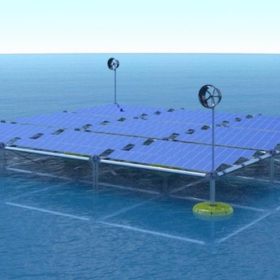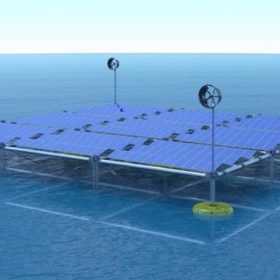Solar arrays on wave energy generators, along with wind turbines

German startup Sinn Power has combined wave, wind and solar power to create what it claims is the world’s “first floating ocean hybrid platform.”
Germany’s Sinn Power has developed what it calls the world’s “first floating ocean hybrid platform” by combining wave, wind and solar power.
The Gauting-based startup has secured $6.2 million from Schweizer Kapital and a German government ministry since its founding in 2014. According to a recent article in Forbes, the company hopes to offer solar panel manufacturers the chance to test PV solar arrays on a floating platform at Heraklion, off the Greek coast, as part of an off-grid energy platform.
“The floating platform can supply renewable energy to islands across the world … and contribute to the worldwide implementation of offshore wind farms,” CEO Philipp Sinn told Forbes.
The modular unit can be equipped with a 20 kW solar array and up to four small 6 kWp wind turbines. Sinn Power says it wants to provide “people living near coasts all over the world with access to clean electricity” and “turn the unlimited power of ocean waves into clean and cost-efficient energy.” It claims to operate fully functional prototypes at its research location in Heraklion and says it is “on the verge” of commercializing its technology.
Despite the potential energy held within waves and tides, the wave and tidal energy industry has been stuck in the demonstration phase for decades, as companies have been unable to overcome immense technical and financial hurdles. A renewable energy investment bubble sent capital to wave companies in the aughts, but recent funding has largely been restricted to government programs for demonstrations and tests.
Wave of bankruptcies
The wave and tidal energy market is littered with bankruptcies, including companies such as Aquamarine Power, Finnevera Renewables, OceanLinx, Pelamis, Verdant Power, and WaveGen. The companies remaining in the market – including Nova Innovation and Wave Star Energy – are, at best, niche power providers for oil and gas, defense, and research. Ocean Power Technologies, the only publicly listed wave energy company, had revenue of just $600,000 in the 12 months to the end of April 30, 2019.
It’s feasible that wave energy equipment can be made reliable, just as the offshore drilling industry has demonstrated with its hardware – but it’s very expensive. The sector was non-competitive 20 years ago and is even less competitive now, with the advent of cheap natural gas, offshore wind, and onshore solar.
The artist’s renderings for the platform include small wind turbines and ducted wind turbines – inefficient solutions both. As for putting roof-top solar panels and electronics on the open ocean – check your warranty and IEC 61701 salt mist corrosion testing.


